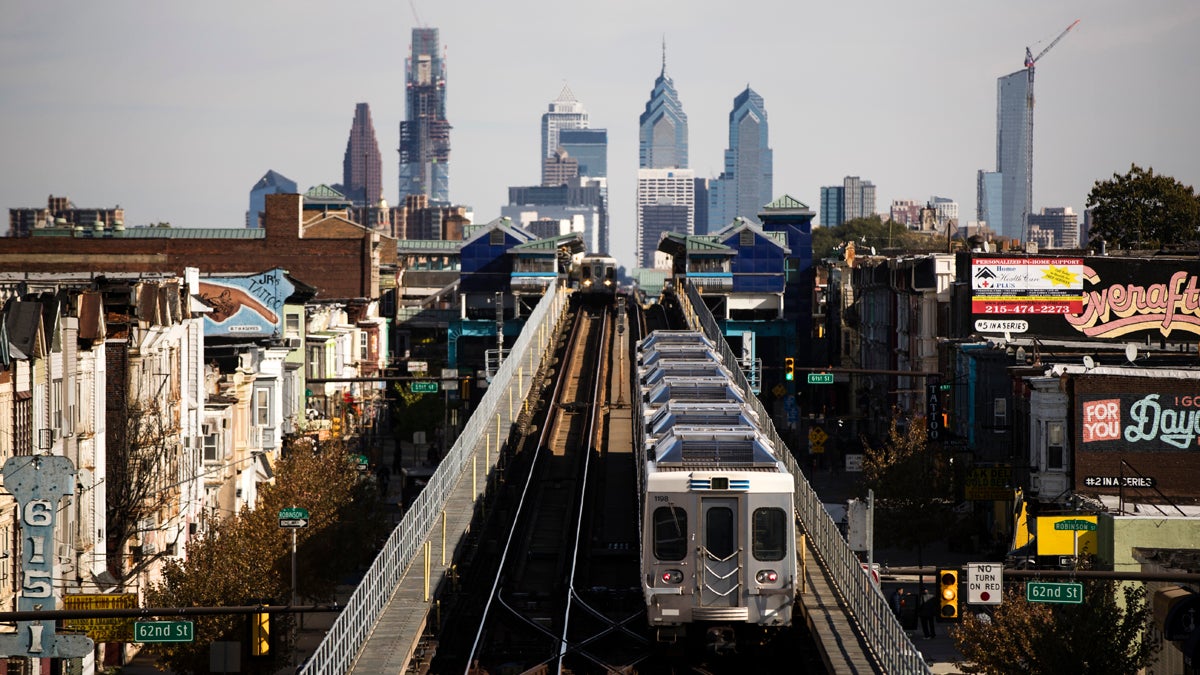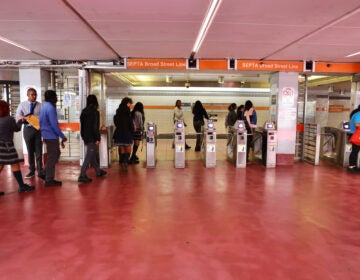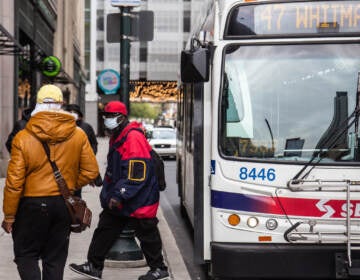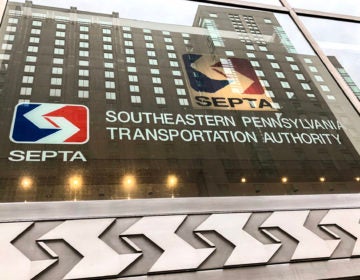4 ways SEPTA can reduce COVID-19 risks on transit
COVID-19 has hurt SEPTA immensely. Now is the time to make changes to protect riders and employees while strengthening the system for the future.

A train moves along the Market-Frankford Line. (Matt Rourke/AP Photo)
As Philadelphia slowly recovers from the pandemic and lockdown, and people resume traveling to places they haven’t gone to for months, our region’s transit still faces a long-term funding crisis from collapsed ridership not seen in decades. The initial CARES act funding in April will only keep SEPTA afloat for a year at most, with no certain prospect of future bailouts. And while SEPTA’s new fare policy includes compelling new incentives in the free transfer and $1 youth fare, if traveling habits are permanently altered coming out of the crisis, SEPTA will have to significantly reimagine and refocus the service it provides to people still willing to take transit.
While SEPTA has largely relied on a campaign of deep-cleaning of stations and sanitizing surfaces, this cannot change the fact that the coronavirus is primarily transmitted through the air, and likely only a regimen of mask-wearing and managing vehicle crowding will ensure that transit remains a vital service without becoming a transmission vector. Certainly, providing free masks is the strongest response the agency can make while the coronavirus lingers, as Billy Penn witnessed many riders still unmasked.
But there are other long-term actions SEPTA can take to protect current riders and its own bottom line by bringing riders back with improved service. These include increasing bus frequency at midday and evening hours, speeding up the bus, reimagining Regional Rail, and overhauling signage and branding. These suggestions, developed in association with 5th Square Transit, would help regain confidence in the system, bringing existing riders back, reducing the worries of riders who never stopped riding SEPTA, and even tapping into historically underserved rider markets.
Increase access throughout the day
Providing useful transit frequency during the mid-day, evenings, and late nights was a long-standing issue long before the pandemic, especially for people in healthcare, retail, warehousing, etc., whose work is now deemed essential. As occupations and shifts outside the peak commuting hour continue to proliferate, SEPTA has maintained service levels far poorer than the minimum 15 minutes considered high-frequency, even as cities have found crowding is now highest around noon.
Looking at SEPTA’s route statistics, while a.m. and p.m. peak headways on all routes average at 14 minutes, mid-day and evening service jumps to 25 minutes, and on weekends worsens to a bus every 30 minutes or worse. It’s this situation which has directly contributed to excessive overcrowding and skipped stops, leaving riders at higher risk of exposure.
When analyzing SEPTA’s bus network in 2018, transit consultant Jarrett Walker found that higher bus frequency has a very strong relationship to overall productivity (in boardings per hour); transit is safer and more useful when more people can access it. Because riders transfer between buses and subways all over the network, adequate frequency between any two routes is the only way the agency can ensure abundant freedom and opportunity of mobility for every resident. And for SEPTA, it also makes good budgetary sense to “spread out the peak”, because it costs less to run buses consistently all day than squeeze out more service at rush hour.
Speed up the bus
The most dire predictions coming out of the pandemic assert that because of long-term commute pattern shifts, transit riders could flock to driving en masse. While the prediction itself is debatable, 2020 already began as another year of steadily declining transit ridership and increasing car travel nationwide, threatening downtowns with overwhelming traffic congestion and grinding buses to a halt.
Many peer cities — such as Boston, New York, D.C. and Los Angeles — before and since the pandemic are rolling out bus lanes in stride as a direct response to a lull in current traffic, cognizant of the ideal opportunity at hand. But Philadelphia, while also a member of the list of U.S. cities with slowest bus speeds, has not built a single new bus lane in decades, and has yet to activate camera enforcement on Chestnut Street. Now is the time for the City to partner with SEPTA and roll out long-awaited bus lanes across the city.
Identifying and rolling out bus-only corridors would be the city’s first major contribution towards SEPTA’s Comprehensive Bus Network Redesign, which urges priority bus lanes as a prerequisite for a better network, ultimately aiming to benefit nearly 600,000 bus riders across Philadelphia’s streets.
Reimagine Regional Rail
Across cities, the one transit mode that has persistently seen the highest ridership attrition in the pandemic is commuter rail, and SEPTA’s Regional Rail is no different at -97% decrease. With offices continuing to enforce work-from-home policies even in most days of the week, it is very likely that this mode, which has traditionally enjoyed the highest farebox recovery rate, now faces an existential crisis.
But this also presents the opportunity to truly rethink the concept of Regional Rail, from a premium-priced service for suburban commuters towards a democratized cheaper and frequent extension of the transit network. Philadelphia is fortunate to have five Regional Rail lines terminate within the city, which is a great place to start.
A recent report from the Pew Charitable Trusts found that lower-income job locations spread out far beyond the Center City transit shed, which Regional Rail would be more capable of serving than a lengthy crosstown bus. And for thousands of residents living in outer neighborhoods like Mt. Airy, a trip on a Regional Rail line would save over one-third of the time in a commute to Center City as on a bus and subway.
All this and more point to improving Regional Rail as a central issue of equity. To survive this moment, SEPTA needs to look beyond the needs of the richer and whiter 9-to-5 rider. 5th Square’s petition to lower fares and passes on Regional Rail within Philadelphia would be a cheap but effective start.
Overhaul the system’s branding and wayfinding
In the interest of public health and to regain rider confidence, many agencies have added real-time indicators that monitor crowding levels on buses and train cars on their apps. While SEPTA would also be wise to adopt this feature, this also reflects the unfortunate reality that many of the agency’s rider-facing user interfaces and physical wayfinding have not been refreshed for decades, and new features are confusingly implemented and little-used.
It may seem like a small thing, but increasing the legibility of SEPTA’s network for riders both new and experienced helps demystify and unlock more of the system for them, and would easily increase the perception of a high-quality customer experience. A design overhaul would help resume everyone’s lives with a modernized and accessible SEPTA experience. To SEPTA’s credit, they have begun the process of drafting a branding/wayfinding master plan, and will soon be actively seeking collaboration with the public on the best options to use for stations and maps.
Ben She is a volunteer with Philly’s urbanist and transit advocacy group, 5th Square, and in the Urban Strategy master’s program at Drexel University. A lifelong SEPTA rider, he is deeply interested in issues of transit access and equity.

Subscribe to PlanPhilly
WHYY is your source for fact-based, in-depth journalism and information. As a nonprofit organization, we rely on financial support from readers like you. Please give today.






![CoronavirusPandemic_1024x512[1]](https://whyy.org/wp-content/uploads/2020/03/CoronavirusPandemic_1024x5121-300x150.jpg)


